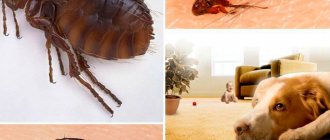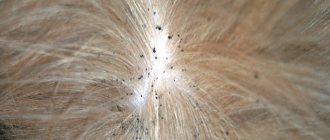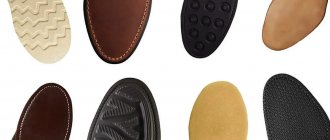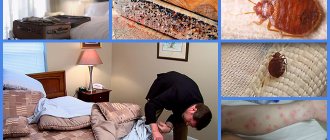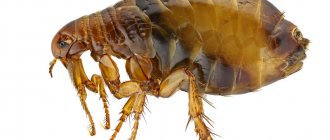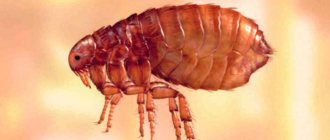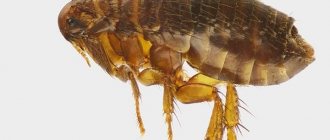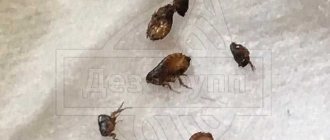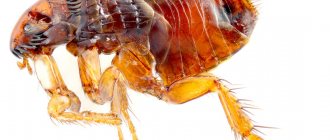If a pet has fleas, they can threaten not only the health of the pet, but also people. These parasites can carry over 25 dangerous diseases. Therefore, the question of how to get rid of fleas in the house quickly at home is quite popular.
If fleas appear in the house, you need to get rid of them.
Causes of fleas in the house
Insects are often brought indoors from the street by a pet dog or cat, or by people on shoes, clothes, or in a bag of groceries.
Other common factors for fleas in the home include:
- movement of parasites through the ventilation system or cracks;
- entry from public corridors and entrances;
- from rodents;
- lack of hygiene, unsanitary conditions;
- dust that appears after major repairs.
The spread of fleas is often facilitated by dampness that occurs in apartment bathrooms and basements. Insects can move from attics and basements, especially if rodents have been poisoned there using chemicals. Therefore, parasites often attack apartments on the top or first floor.
Can't remove fleas
Pests are tenacious creatures, and therefore it is not always possible to get rid of them. Products that instantly kill fleas in one home may not control them in another.
If you cannot kill the insects on your own, then contacting a disinfection service will help. Professionals have a better chance of hitting fleas correctly. Masters of their craft use methods that have been proven over the years and destroy fleas in 1-2 procedures.
Disinfection will cost more than pest control yourself. However, if you cannot destroy the fleas, then you cannot hesitate. They can infect an animal or person with dangerous diseases, the treatment of which will take many times more money, time, and most importantly, health.
Habitats
Having found out where fleas come from, it is necessary to determine their favorite habitats.
This:
- floor coverings: parquet, laminate, linoleum, carpet, carpet;
- cloth;
- bed sheets;
- Kids toys;
- bin;
- cushioned furniture;
- pet bedding;
- baseboards, gaps between them.
Parasites can live in wardrobes. There they make nests in the cracks of furniture and linens. Often such insects are found in birds kept in cages.
Meeting the bouncy “neighbors”
Unwelcome guests are signaled by painful bloody flea bites on a person. Most often they bite the legs, since the insects live on the floor and cannot fly. The flea is ideally built for a parasitic lifestyle. This is a small insect, barely visible to the eye, protected by “armor”.
Powerful hind legs help to nimbly jump half a meter in length and 30 cm in height. The body of the insect is streamlined and flat with small hooks to make it more convenient to cling and linger on wool and fabric. It is for this reason that silk was valued in ancient times, as it did not allow parasites to cling to it.
There are more than 2000 species of insects in nature. Among the variety of blood lovers, there are “vegetarians” who parasitize green plants, feeding on sap and causing a lot of inconvenience to gardeners. Due to their small size—the largest individuals have a body length of 0.5 cm—fleas easily penetrate a person’s home and “settle in” well there. Household fleas love to parasitize dogs, cats, birds, and rodents. Most often they hide in upholstered furniture, behind the baseboard, near the radiator, in the pile of the carpet, soft toys, under the sink. Animal bedding is an excellent “nursery” for breeding offspring.
Small parasites live in a variety of environments. For example, grass or earth fleas, as the name implies, like to hide in bushes and grass, waiting for their prey. Linen fleas thrive on cotton and linen fabrics. In fact, these are the same parasites, and the common name indicates only the habitat. The most common fleas are red and black. This is the same species, but only at a different stage of development. Redheads are younger individuals that will later acquire a darker color.
A flea needs favorable conditions. The ambient temperature should be around 17-26°C. At −15°C, parasites try to leave the room, which does not allow them to lay eggs and raise larvae. Humidity - no more than 70%, otherwise the offspring will die. Fleas actively reproduce in summer and autumn. In winter they prefer to live in the fur of a warm-blooded animal.
Types of domestic fleas
There are several varieties of domestic fleas: dog, cat, human, etc. Some of them carry dangerous infections.
Cats and dogs
Cat fleas are the most common type of parasite. They feed on the blood of not only cats, but also dogs (and even humans). This type of insect most often attacks people. Fleas can grow up to 5 mm in length. They have a dark body, slightly flattened on the sides. The mouthparts of insects are piercing-sucking. Their bite is extremely painful, leading to skin irritation, itching, and rashes. When scratching, pustular inflammation appears.
Dog fleas feed on the blood of dogs. If they do not find a main source of food, they can switch to a cat or person to satisfy their hunger. This type of parasite can survive without food for several months. Fleas' mouths are designed in such a way that they penetrate the skin and suck in blood.
The body of the insect is flat. Covered with a large number of bristles and ridges, due to which there is strong adhesion to dog hair. The structure of the body allows the flea to easily jump from one animal to another.
Bedding and linen
Flea habitats in the house.
Bed and linen fleas live in sleeping areas. They appear if the bed linen has not been washed for a long time or dust has accumulated in the crevices of the bed.
They attack people at any time of the day. Such insects reach a length of 2-3 mm.
Their body is shiny brown, slightly compressed on the sides. The body is covered with a chitinous layer that performs a protective function. The oral apparatus is presented in the form of a proboscis. Bites cause severe allergic reactions, as well as nervous system disorders.
Herbal and earthy
Grass fleas live in grass and feed on the sap of trees, shrubs and plants. Ground insects live in the sand or in the ground, but they satisfy their hunger only with blood. Outwardly, they strongly resemble ordinary parasites. They grow to 2-3 mm in length. The proboscis ends in the middle of the chest. When fleas appear in a house, they can bite animals and humans. The bite of such an insect causes severe redness around the wound, since the substance it secretes into the blood is a strong allergen.
How dangerous are flea bites for humans?
Often, domestic flea bites cause a severe allergic reaction , including shock and swelling. And if 1-2 bites are not yet so dangerous, systematic flea attacks lead to the following consequences for the body:
- Extensive rashes appear around the bites;
- the temperature rises, swelling appears;
- lymph nodes enlarge;
- in places where scratching occurs, painful suppuration occurs (in advanced cases, the appearance of ulcers and pyoderma);
- insomnia, constant stress, phobias of various nature;
- neuralgia;
- infection with dangerous infectious diseases and the possibility of acquiring internal parasites.
Due to the anesthetic substance that the flea injects under the skin, the bite is initially painless, but after a short period of time severe pain appears. If we compare domestic fleas with other parasites of a similar nature, they have the most painful bite and a huge number of diseases they carry. The domestic flea, due to its random distribution, is extremely difficult to remove, while with other parasitic insects, only nests or places of accumulation can be treated.
Methods of destruction
To get rid of fleas, disinsection measures are carried out, which involve the use of chemicals and folk remedies.
Professional pest control
To eliminate fleas from your home once and for all, you can use the services of a special service. Professionals will help you quickly remove all insects from the room, but you will have to pay dearly for the work done.
Advantages of professional pest control:
- use of effective and harmless means;
- no re-processing required;
- specialists are dispatched even on weekends and holidays;
- a guarantee is provided for the service performed;
- During work, special equipment is used to permanently destroy emerging parasites.
Exterminators use special chemicals. Fog is used to kill fleas. Using a generator, insecticides that contain microparticles of chemicals are sprayed. In addition, when treating the most difficult to reach areas, specialists perform disinsection manually.
Chemicals
Help you fight fleas indoors on your own:
- aerosols and sprays;
- contact preparations in the form of suspensions or powders;
- crayons.
Almost all drugs negatively affect the nervous system of insects, blocking the transmission of impulses. Because of this, fleas become paralyzed and die. Such products contain different active ingredients: pyrethroids and organophosphates.
Preparations of the pyrethroid group are characterized by a slightly delayed action, resulting in a long-lasting effect. Products based on organophosphorus compounds have an ovicidal effect, that is, they help rid the room of adults and eggs. These include the drugs Dichlorvos and Karbofos.
Chalks are used to control fleas. This poison is used to treat surfaces in places where it is not possible to use another product. The crayons are slightly toxic, so they are mainly intended for preventive purposes.
Means for getting rid of fleas.
Powder is a drug that helps kill emerging fleas. Characterized by long-lasting effects. It is easy to spray in cracks, under cabinets and carpets. This remedy has a poisonous effect when the parasite comes into contact with it.
The most powerful chemicals:
- Spray Raptor. It helps fight blood-sucking parasites and does not harm humans. This remedy can poison even hatched larvae, since its effect lasts 3 weeks.
- Sinuzan. The drug is considered professional. Quickly and permanently rids the room of fleas. Its only drawback is its pungent, unpleasant odor.
- Chlorpyrimark. Helps kill fleas, bedbugs, ants, flies, cockroaches in the apartment. The effect of use lasts 1.5 months.
- Biorin. Product of increased toxicity. It lasts 8 weeks, and insects begin to die immediately after treatment. Has a pungent odor and is unsafe for pets and children.
- Pyrethrum. This is a powder that is made from ground chamomile inflorescences. They treat all hard-to-reach places in the rooms.
Before using any drug, you should carefully study the instructions.
Folk remedies
Not all chemicals are effective or safe. When using them, a severe allergic reaction may develop. Therefore, harmless folk remedies come to the rescue.
To get rid of fleas, you can make herbal infusions. They have a specific smell that repels insects. Basically, parasites cannot tolerate the aroma of tansy, eucalyptus leaves and wormwood. Take 1 tbsp. l. plants, pour 200 ml of boiling water and leave for half a day. The liquid is used to wipe walls, floors, clothes, and household items.
Bunches of fresh grass laid out on the floor provide quick results. Another effective method is the use of essential oils. Fleas do not like anise, clove, mint and eucalyptus aroma, so it is recommended to treat all surfaces in the room with such oils.
Parasites do not tolerate the smell of pine needles; when it appears, they immediately leave. If fleas have infected an animal, you need to fill its bedding with pine sawdust. When washing clothes or bathing a pet, it is recommended to add pine decoction to the water. Parasites cannot tolerate the smell of garlic. A fraction of the product is crushed and mixed with brewer's yeast. The resulting mixture is used to wash the floor.
If there are fleas in the house, citrus peels are used to rid the room of them. To do this, the peel of a tangerine, lemon or orange is laid out in places where insects were found. Ordinary salt and baking soda are also used for these purposes. Take these components in equal proportions, mix and scatter on the floor. Salt, once on the parasite's shell, begins to corrode it, leading to the death of the flea.
Folk remedies for getting rid of fleas.
You can remove pests using tar oil. To do this, the product is ground on a grater and diluted with hot water. The solution is used to treat the surface of furniture, walls, doors, and floors.
Vinegar is used to prevent the appearance of parasites. All surfaces and floors are treated with a highly concentrated solution, and hard-to-reach places are sprayed with it.
Heat treatment
In order for fleas to live, they need an optimal temperature. If it changes for the worse, the apartment parasites will die. Therefore, it is possible to create such unfavorable conditions for them.
To do this:
- Freezing. This involves ventilating the apartment in severe frost, when the temperature drops below -20°C. This method is effective, but has its drawbacks. For example, pipes may be damaged.
- Heating. In this case, the temperature is artificially increased to +50°C. Engineering communications are not affected, but this procedure is more difficult to complete. To do this, they call in special teams with heat guns.
When home remedies don't work...
What to do if you've tried everything, but fleas are still thriving in your apartment? It's time to get rid of fleas using serious methods. For example, use this “steam bomb” for fleas. By the way, it can also be used in the fight against cockroaches, as well as ants in residential areas.
I’ll say right away that it helps when fleas no longer have access to you, for example from a neighboring apartment. A friend of mine tried to get rid of fleas using such an aquafumigator and it only helped him half.
Store-bought bed bug remedies.
Therefore...if no flea remedies help, there is only one way out - call an exterminator. Yes, it is more expensive, yes, everyone will have to leave the living space for a day or two, including animals and aquarium fish, and everything related to food and direct contact with the body will need to be hidden. It’s definitely more trouble, but fleas brazenly walking around your bed cause a lot more discomfort, don’t they?
This method works, tested. In addition, as a rule, companies provide a guarantee and if after some time the fleas begin to visit you again, the pest control company will treat the premises again free of charge.
Preparing the room for processing
Before you start treating a room for fleas, you need to prepare it. If an animal lives in the house, its bedding is washed in hot water or thrown away. Do the same with the blanket on chairs and sofas if your pet likes to lie on it. All tile and wood floors, linoleum and carpeting are thoroughly vacuumed and wet cleaned.
Upholstered furniture is vacuumed or cleaned with detergent, carefully treating the locations of the sofa cushions. After cleaning is completed, the replacement bag is removed from the vacuum cleaner, placed in a plastic bag and thrown outside into a container. It is also recommended to treat the animal for fleas.
If there is an aquarium in the apartment, it is necessary to cover it tightly with a lid and turn off the artificial air aeration compressor. If even one drop of insecticide gets into the water, all the fish will die. When preparing the room, toys and other things are removed from the floor. Animals that are kept in a cage (hamsters, reptiles, birds) are taken out of the apartment. Dishes and food are carefully packed in film or hidden in a closet.
If it is necessary to treat the courtyard area of a private house, it is necessary to remove all objects located there. The bedding in the dog house is thrown away or washed in hot water. It is recommended to mow the tall grass and clear the yard of various rubbish.
Prevention
It is much easier to prevent an infestation than to get rid of fleas. Preventive measures are as follows:
- Regularly clean the premises, vacuum carpets, furniture and floors, and ensure that the porch is clean. Wash floors with soap, essential oils, ammonia, vinegar;
- Do not wear dirty shoes in the house, do not store unwashed shoes;
- After walking animals, wash their paws and inspect their fur, and periodically change collars. Apply flea control products in spring, summer and autumn;
- Avoid contact with stray animals;
- Do not go into dirty abandoned buildings, there are usually a lot of parasites there;
- When outdoors, wear long sleeves and long pants to prevent insect bites. Fleas don't often bite the upper body area because they can't jump there. Use protective equipment;
- Prevent the spread of bats and rodents in a wooden private house and on the site, as they carry parasites;
- Carefully handle items purchased at markets;
- Keep your yard open and plant repellent plants. They are considered to be wormwood, garlic, lemongrass, tansy, citronella;
- When traveling to Southeast Asia, South America or Africa, avoid visiting areas where there is a risk of sand flea infestation. For prevention, you should get vaccinated and apply protective ointments.
It is possible to destroy parasites yourself. If the above methods do not help, you can call a team of specialists.
Source:
Destruction of parasites in the basement
Fleas often live in basements with high humidity and poor ventilation. Therefore, these rooms also need to be treated against insects. Leaking pipes that cause a lot of moisture in the basement should be repaired. Fleas often lay eggs in cracks, so such cracks should be thoroughly cleaned of debris. There is always a lot of dust in the basement, so before cleaning the floor is sprayed with water so that particles of debris with parasite larvae do not settle on the ceiling and walls.
The concrete floor in the basement is washed using bleach or a strong soap solution. To ventilate the room, open all hatches and windows. Processing of the basement begins after the floor is completely dry. To do this, dilute the disinfestant according to the instructions, without exceeding the required dose. You can use the drugs Diazinon, Tetrix, Sinuzan and Kukuracha.
Many chemicals must be diluted with water. Using a sprayer, the drug is applied to the floor and walls. To completely rid the room of fleas, it should be treated 2 more times. This helps destroy both adults and eggs.
Effective chemicals against fleas
The best remedy for fleas is prevention and keeping your home clean. Regular washing of surfaces, vacuuming, ventilation and treatment with disinfectants greatly reduces the risk of an unpleasant neighborhood. But if you still have household fleas, chemical agents will help get rid of them; let’s look at the main ones.
Flea sprays
The insecticidal substances contained in aerosols affect the insect's nervous system, leading to paralysis and death. At the moment, this is one of the fastest ways to deal with household fleas, however, you should be careful when using the aerosol, as most of them are toxic to humans and pets. Such products must be used strictly according to the instructions; processing must take place in stages.
- Before processing, wet cleaning is carried out and excess debris is removed in order to eliminate possible accumulations of larvae and adults.
- Furniture should be moved away from the walls and carpets should be removed.
- It is imperative to remove residents and pets from the apartment, preferably for a day.
- The aerosol is sprayed in areas of suspected accumulation (cracks, baseboards, doorways, seams on upholstered furniture).
- After treatment, close all doors and windows.
- After the time specified in the instructions, the apartment or private house is thoroughly ventilated, the carpets are vacuumed, and wet cleaning is done again.
Aerosols that have proven themselves are: Flee, Combat, Raid, Control Home Flea&Tick Killer, Clean House, Executioner, Raptor.
Solutions, emulsions and concentrates for fleas
Concentrates are diluted with water in accordance with the instructions, application occurs using a spray bottle (it is also convenient for them to treat surfaces with solutions and emulsions).
When applied, a film is formed, in contact with which insects die. The distinctive advantage of such products is that they do not require reapplication, as they have a long-lasting residual effect. The following received good reviews: Tsifoks, Get, Butox, Cucaracha, Tetrix .
Flea dusts and powders
Due to the nature of their application, powders and dusts are more effective in non-residential premises - warehouses, basements, attics. Such products have shown themselves especially well in places with a high degree of infestation due to the destruction of not only adult fleas, but also their larvae.
Actions after disinfestation
You should enter a cleaned and treated apartment after it has been thoroughly ventilated. Carry out wet cleaning of places that have to be touched, except for the floor. When sprayed, the chemical may accidentally get on door handles, armrests, or table surfaces. Treatment with a soap-soda solution neutralizes the effects of the insecticide.
Types of fleas.
The bed is covered with clean linens, armchairs and sofas are covered with washed bedspreads. Then the lid is removed from the aquarium, the artificial air compressor is turned on, and children and pets are brought in. It is not recommended to wash the floor for 2 weeks after treatment. Upholstered furniture and floor coverings should be vacuumed every day to remove dead insects.
When is professional pest control necessary?
If there are a lot of fleas and self-treatment does not bring lasting results, you need to contact a professional. Exterminators use powerful products that cannot be found over the counter. In addition, specialists have special equipment that ensures the supply of insecticide to all cracks and hard-to-reach places. There is no need to be afraid of furniture damage; there will be no traces left after such a procedure.
Practical recommendations
In order to no longer encounter such a problem as fleas in your apartment, you need to adhere to the following recommendations:
- treat your pet regularly with anti-flea products;
- regularly wipe floors with insecticidal solutions or bleach;
- do not accumulate unnecessary things in the attic;
- periodically knock out pillows, mattresses, rugs, carpets;
- change bed linen every 3 days.
In addition, cut wormwood or tansy should be kept in the basement of the house. Fleas do not like such plants and will avoid these places.
How to prepare an apartment for disinfestation (destruction of fleas)
Before you start killing fleas, you need to properly prepare your apartment. The effectiveness of disinfestation will depend on the actions taken.
And you need to do the following:
- Wash bed linen and put away.
- Place food in well-closed cabinets or refrigerators.
- Clean all upholstered furniture with detergent.
- Cover household appliances and flowers with film.
- Vacuum carpets.
- Carry out a thorough wet cleaning.
- If you have pets, temporarily find them another place to stay, and treat their belongings at high temperatures or dispose of them.
After the preparatory work has been completed, you can safely begin processing the room.
The danger posed by fleas
In addition to discomfort and moral dissatisfaction, fleas are carriers of various diseases. Among the common ones:
- hepatitis;
- encephalitis;
- brucellosis;
- helminthiasis (including pumpkin tapeworm infection);
- endemic typhus;
- tularemia;
- pseudotuberculosis;
- melioidosis;
- erysipeloid;
- anthrax.
This is not a complete list of what you may encounter. Therefore, you should not ignore the problem and delay treatment. The consequences can be sad for the whole family.
The reason for studying fleas was the fact that the insects carried a terrible disease - the plague.
Ways to control fleas
Since when fleas enter an apartment, they immediately occupy all areas and quickly find the most comfortable, but secluded or hard-to-reach places, it can be quite difficult to get them out. You can get rid of insects that have settled in furniture upholstery, thick pile of carpets or under baseboards using special preparations offered by the industry and homemade products . To choose the most suitable disinfestation method for a particular situation, it is worth learning more about them.
Carpet cleaning and room cleaning
The first assistant in cleaning rooms and carpets is a vacuum cleaner. You need to use it every day, walking over baseboards, floor coverings, and furniture. Particular attention is paid to the places where the pet lives. Also, thorough cleaning is required in wet areas. Vacuum cleaning is carried out daily for 1-3 weeks.
The dust and debris collection bag of the vacuum cleaner should be cleaned outside. If you throw the filling into a bucket, the insects will quickly leave it in a short period of time.
It is worth considering the option of using a steam unit for cleaning carpets and furniture. If such a thing is not available on the farm, you can invite a cleaning company. Well-heated steam can destroy adults, larvae and eggs.
In addition to a vacuum cleaner, it is recommended to use insecticidal sprays. The contents of the bottle are sprayed onto carpets and furniture upholstery, and the surfaces are allowed to dry. After this, cleaning is done with a vacuum cleaner. In this case, you cannot do without it, because the drugs are most often active against fleas, but not eggs.
Alternative carpet cleaning methods:
- spraying with vinegar solution (water and vinegar are taken in equal volumes);
- treatment with lemon infusion (2-3 lemons are cut into slices, poured with water, boiled and left for 12-24 hours);
- washing the coating using insecticides;
- dry cleaning.

